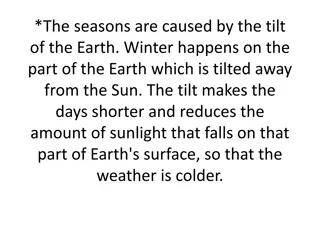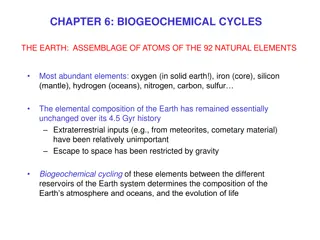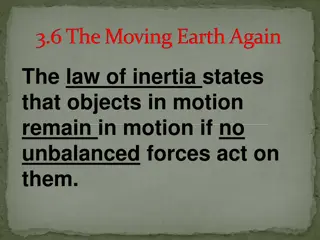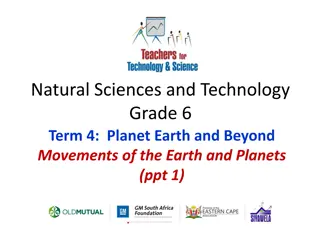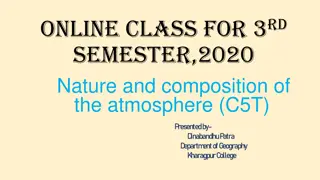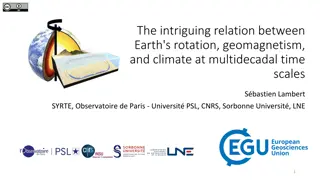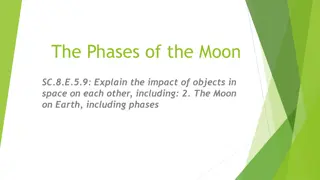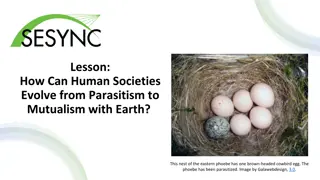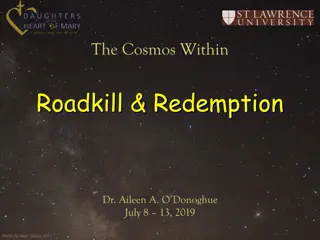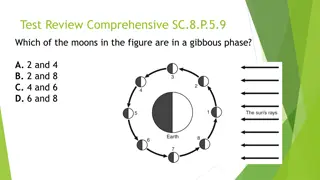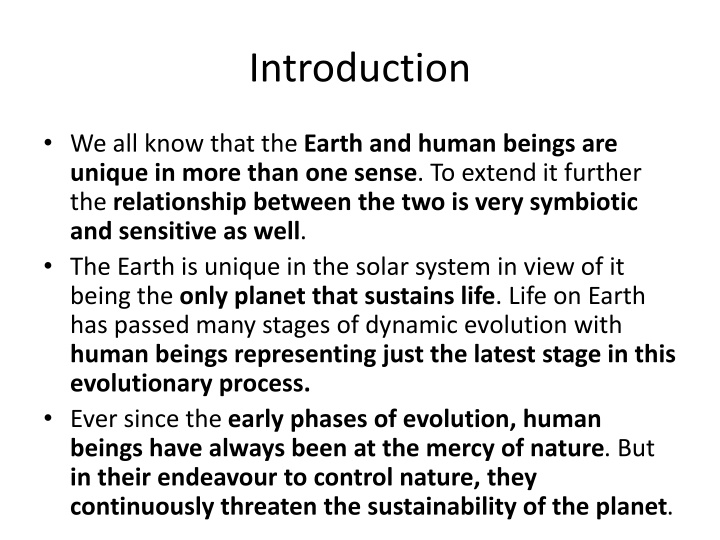
The Unique Relationship Between Earth and Human Beings
Earth sustains life in the solar system, but human activities are causing environmental changes. Understanding global environmental issues is complex due to diverse stakeholders and lifestyle changes needed.
Download Presentation

Please find below an Image/Link to download the presentation.
The content on the website is provided AS IS for your information and personal use only. It may not be sold, licensed, or shared on other websites without obtaining consent from the author. If you encounter any issues during the download, it is possible that the publisher has removed the file from their server.
You are allowed to download the files provided on this website for personal or commercial use, subject to the condition that they are used lawfully. All files are the property of their respective owners.
The content on the website is provided AS IS for your information and personal use only. It may not be sold, licensed, or shared on other websites without obtaining consent from the author.
E N D
Presentation Transcript
Introduction We all know that the Earth and human beings are unique in more than one sense. To extend it further the relationship between the two is very symbiotic and sensitive as well. The Earth is unique in the solar system in view of it being the only planet that sustains life. Life on Earth has passed many stages of dynamic evolution with human beings representing just the latest stage in this evolutionary process. Ever since the early phases of evolution, human beings have always been at the mercy of nature. But in their endeavour to control nature, they continuously threaten the sustainability of the planet.
Alarming Change in the 20thCentury Our environment is dynamic and it is constantly changing and evolving in response to stimuli. Yet in the 20thcentury, it became apparent that mankind is having an increased effect on the planet s eco-systems and biogeochemical cycles so much so that these activities are now causing environmental change, which is overriding the natural dynamism of the earth. Yet despite the evidence of environmental problems such as loss of biodiversity, land cover changes as evident from satellite imagery, records of climate change; human beings still pursue activities which perpetuate the problems. As the world s population increases and the per capita consumption of natural resources rise, there will be certainly more environmental problems if corrective steps are not taken at the earliest.
Difficulties in Discussion on Environmental Issues This is due to three broad reasons. First, the science of environmental problems is very complex. This is so as we are dealing with many interrelated dynamic systems. Secondly, there are many stakeholders involved in both the causes and solutions to environmental problems. Organizing all of these stakeholders to act in a coordinated manner is difficult. Thirdly, resolving global environmental issues will require changes in our own consumption pattern, which will mean changes in lifestyles. This requires commitment at the personal level which everyone may not like.
Human-environment Interaction Human-environment interaction involves not only the question of resource use per person, but also our ability to understand the science of the environment, our ability to regulate our impact on the environment, our beliefs in the value of the environment and our ability to negotiate solutions at both the local and the global level. An attempt will be made here to discuss global environmental issues from a scientific and socio- economic viewpoint so that they are understood not only as a contested science concerning natural resources, but also as political and social issues. Three important parts must be taken into consideration:
Three Important Parts i. Examination of the historical outline of global environmental issues on the international agenda; ii. Examination of the various senses in which the environment can be said to have become a global issue; and iii. Probing into the global environmental issues in detail.
The Historical Outline The Industrial Revolution was a product of human being s desire to speed up the process of production. Although by the end of the 19thcentury it was clear that the process is causing wide spread damage to the environment the seriousness of the situation was not widely recognized. By the early decades of the 20thcentury pressure from both industrial and agricultural development increased. The atmosphere of large cities in Europe and North America was covered with smoke released by the industrial and domestic use of coal as a fuel. Problems peaked in North America in the 1930s when droughts devastated the Great Plains. Soil erosion was rampant. Plains areas became deserts. The socio- economic condition of the USA and Canada was shattered because of the sheer magnitude of the above problems.
The Historical Outline (contd.) By the middle of the century, the environmental cost of serious pollution was beginning to attract broader attention. Air and water pollution received most attention. But land pollution was not discussed much. The issue of land pollution came into limelight with the introduction of pesticides. It was considered to be a revolution in agricultural sciences. Rachel Carson was the first to draw attention to the implications of these chemicals on the environment. The title of her best selling book Silent Spring referred to the silence that fell over the land as birds succumbed to the chemical poisoning caused by the growing use of pesticides.
First Wave in the Modern Environmental Movement It gave the environment movement a major boost and inspired an increasing amount of research over the next two decades into the problem of environmental pollution by chemicals. This is known as the first wave in the modern environmental movement. The wave gathered momentum with the holding of the first conference to draw worldwide public attention to the environmental problems. The conference is popularly known as the Stockholm Conference. This pivotal event in the growth of the global environmental movement was the first occasion on which the political, social and economic problems of the global environment were discussed at an intergovernmental forum with a view to actually taking corrective action.
Stockholm Conference and its Four Results The Stockholm Conference had four major results: i. First, the conference confirmed the trend towards a new emphasis on the human environment. Earlier, environment was usually seen as something not connected to humanity. ii. Second, Stockholm forced a compromise between the different perceptions of the environment held by developed and developing countries. The needs of least developed and developing countries became a key factor now. iii. Third, the presence of so many NGOs at the conference and the role they played marked the beginning of a new and more insistent role for governments and intergovernmental organizations.
Stockholm Conference(contd.) iv. Finally, the most tangible outcome of Stockholm was the creation of the United Nations Environment Programme(UNEP). Though it had limitations and difficulties it was probably the best form of institution possible under the circumstances. Public pressure forced the political and industrial establishment to reassess its environmental quality. In the mid 1980s there was a major resurgence of environmental problems. It is argued that the resurgence can be attributed to the public backlash against the perceived anti- environmentalism of the Reagan Administration. This phase is known as the second wave in the environmental movement.
The Second Wave The second wave is characterized by a new environmentalism, in which there is a growing awareness of the breadth and complexity of issues. One of the results is that the economic and political components of the issues were now better understood and better addressed than they were in the past. The second wave gave birth to important developments at the international stage. They were the World Commission on Environment and Development (1986), Rio Conference (1992), Kyoto Protocol (1997), and the Johannesburg Summit (2002).
The Brundtland Commission The World Commission on Environment and Development is popularly known as the Brundtland Commission. It firmly combines economy and environment through its promotion of sustainable development. It defines sustainable development as development to be both economically and environmentally sound so that the needs of the world s current population could be met without jeopardizing those of the future generations. The report concluded that environment and development were interrelated and the policy responses were handicapped by the fact that existing institutions tended to be independent, fragmented, too narrowly focused and so tended to address issues such as acid pollution as discrete policy problems.
The Earth Summit Part of the Commission s mandate was to explore new methods of international cooperation that would foster understanding of the concept of sustainable development and allow it to develop further. To that end it promoted a major international conference held in Rio de Janeiro in 1992 popularly known as the Earth Summit. The outcomes of Rio can be summarized in five key agreements: i. The Framework Convention on Climate Change: It established the principle that climate change was a serious problem that needed precautionary measures which could not await the resolution of questions about scientific certainty. It also emphasized the role of developed countries in the production of green house gases. The developed countries also agreed to take steps to cut green house gas emissions to 1990 levels by the year 2000.
The Earth Summit (contd.) ii. The Convention on Biological Diversity: Negotiated under the auspices of UNEP, this convention was aimed at preserving global biological diversity through the protection of species and ecosystems. In view of most of the threats experienced in the least developed countries and most biotechnology based in the developed countries a compromise between the needs of the two sides was attempted. iii. Agenda 21: This was an action plan for sustainable development , integrating the goals of environmental protection and economic development, and based on local community and free market principles. A recommendation was made for the creation of a UN Commission on Sustainable Development to oversee the implementation of Agenda 21.
The Earth Summit (contd.) iv. The Rio Declaration on Environment and Development: This consisted of 27 principles guiding action on environment and development. The declaration tried to maintain a balance between the least developed countries and the developed countries. v. The Forest Principle: It emphasized the sovereign right of individual states to exploit forest resources within the general principles of forest protection and management. Rio drew unparalleled levels of public attention to the problems of environment and represented another major step along the road to a workable resolution of the tensions between environmental management and economic development.
Evaluation of Rio Conference and Kyoto Protocol The major weakness of Rio Conference lies in the extent to which its outcomes were diluted by the need to reach consensus among the dozens of participating states. Despite this criticism, it stood as a clear benchmark of just how far the environmental debate had come in the last twenty years. The Rio Conference also gave birth to the Kyoto Protocol, which is in the centre of international debate for some time. In December 1997, more than 160 nations gathered in Kyoto, Japan to negotiate agreements binding on the developed countries for the control of emission of greenhouse gases. This was the consequence of the Framework Convention on Climate Change held in 1992.
Kyoto Protocol (contd.) The outcome of the meeting was the document, which has now come to be known as the Kyoto Protocol. This document urges the developed nations to reduce the greenhouse gases emissions to a particular level. In fact this provision is the bone of contention among the developed nations. Some of them have argued that it would halt their technological progress. Because of the opposition of the USA and Australia, the success of Kyoto Protocol has not been spectacular. Initially the USA had signed the protocol but withdrew in 2001 owing to the pressure from its domestic circles.
Johannesburg, 2002 After Rio, The United Nations Conference on Environment and Development was held in Johannesburg in 2002. It provided the fundamental principles and the programme of action for achieving sustainable development. The summit reaffirmed sustainable development as a central element of the international agenda and paved the way for the practical and sustained steps needed to address many of the world s passing challenges. Yet among all the targets, timetables and commitments that were agreed upon at Johannesburg, there were no silver bulleted solutions to aid the fight against poverty and a continually deteriorating natural environment.
Johannesburg, 2002 (contd.) In fact, there was no magic formula and no miracle; only the realization that practical and sustained steps were needed to address many of the world s most pressing problems. But some important new targets were established, such as, to reduce the proportion of people without access to basic sanitation into half by 2015; to use and produce chemicals by 2020 in ways that do not lead to significant adverse effects on human health and the environment; to maintain or restore depleted fish stocks to levels that can produce the maximum sustainable yield on an urgent basis and where possible by 2015; and to achieve by 2020 a significant reduction in the current rate of loss of biological diversity.
Thus there is a clear indication that the global environmental movement needs to be reshaped in a way where nation states can look beyond their narrow national interest. There is a lack of consensus among the nation states to resolve these issues. If we look at the history of international cooperation with regard to environmental problems we find that the globe is divided into two blocs. One bloc is a leading producer of greenhouse gases and the other bloc is struggling to provide food to all of its citizens. There is huge gap between the nation states, which also at times poses a challenge for environmental protection on a global scale.
Environmental Issues Becoming Global In several senses environmental issues have become international and global. According to Owen Greene there are five senses in which one can say that environmental issues are global. First, some environmental problems are inherently global. The cause of the problem may be local. But their effect and solution can be visualized at a global level-e.g. carbon dioxide emissions contributing to global climate change. Second, there are some resources which are shared by the whole world. These include atmosphere, the deep- sea bed and outer space which need to be preserved at a global level in the interest of the whole world.
Environmental Issues(contd.) Third, many environmental problems cross national boundaries even though they are not purely global. For example, any environment related hazardous activity in one country would produce changes in neighboring countries-e.g. war in Iraq produced black rain in Kashmir. Fourth, there are many environmental issues which are local or national. But they happen in too many localities. Hence they are considered as global problems. Examples of this include unsustainable agricultural practices, soil erosion, and deforestation. Finally, and the most important among all these is the fact that environmental issues are intimately linked to broader political and socio-economic processes which themselves are part of global political economy.
Environmental Issues(contd.) It is widely recognized that the pattern of wealth distribution, power and industrialization affect the environment in a significant way. Hence globalization and interdependence among nation states give all environmental problems an international dimension. Thus it is very clear that global environmental issues encompass a wide range of problems which are interrelated. However each of these problems needs specific and careful explanation so that effective solutions can be found.


